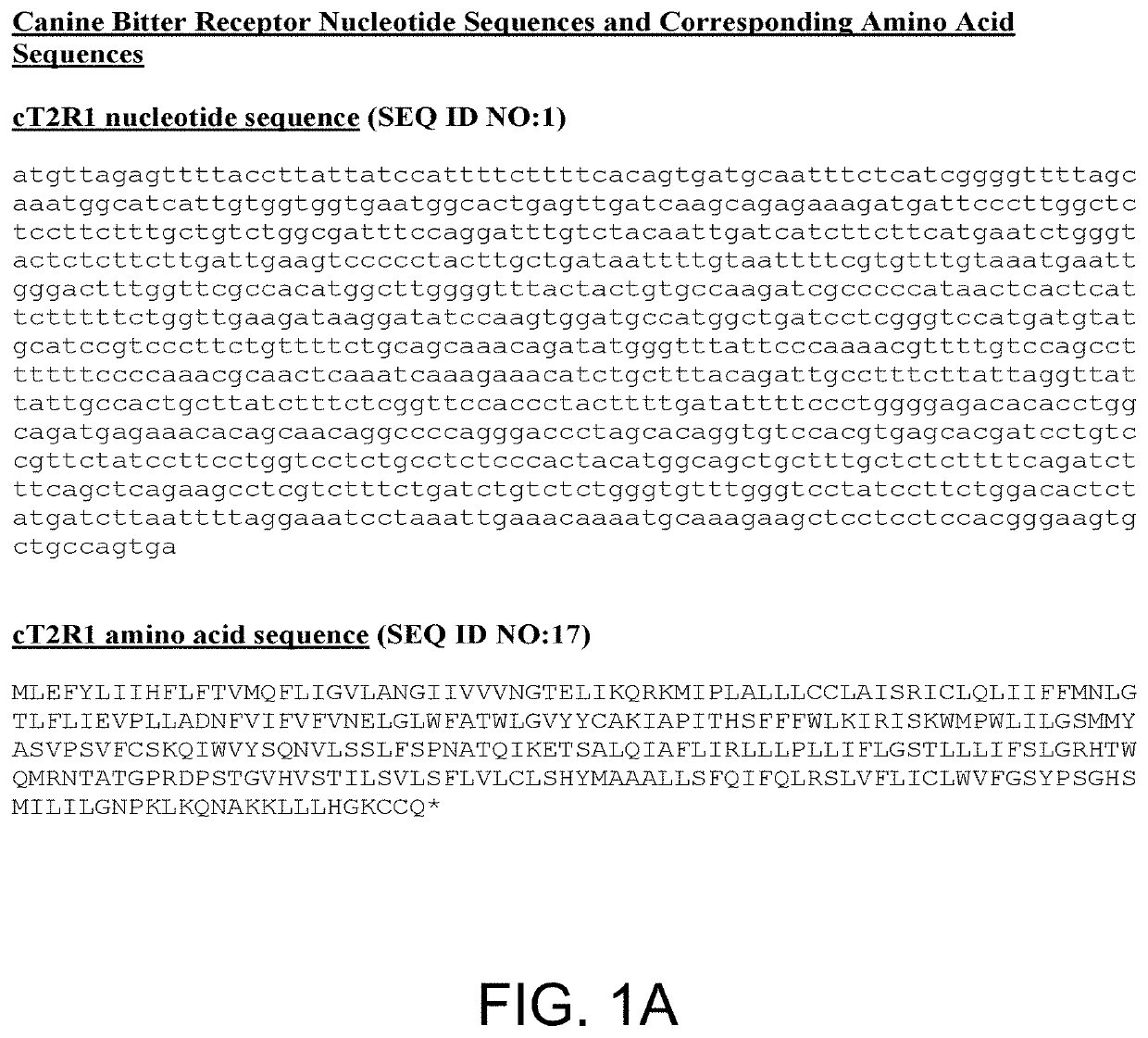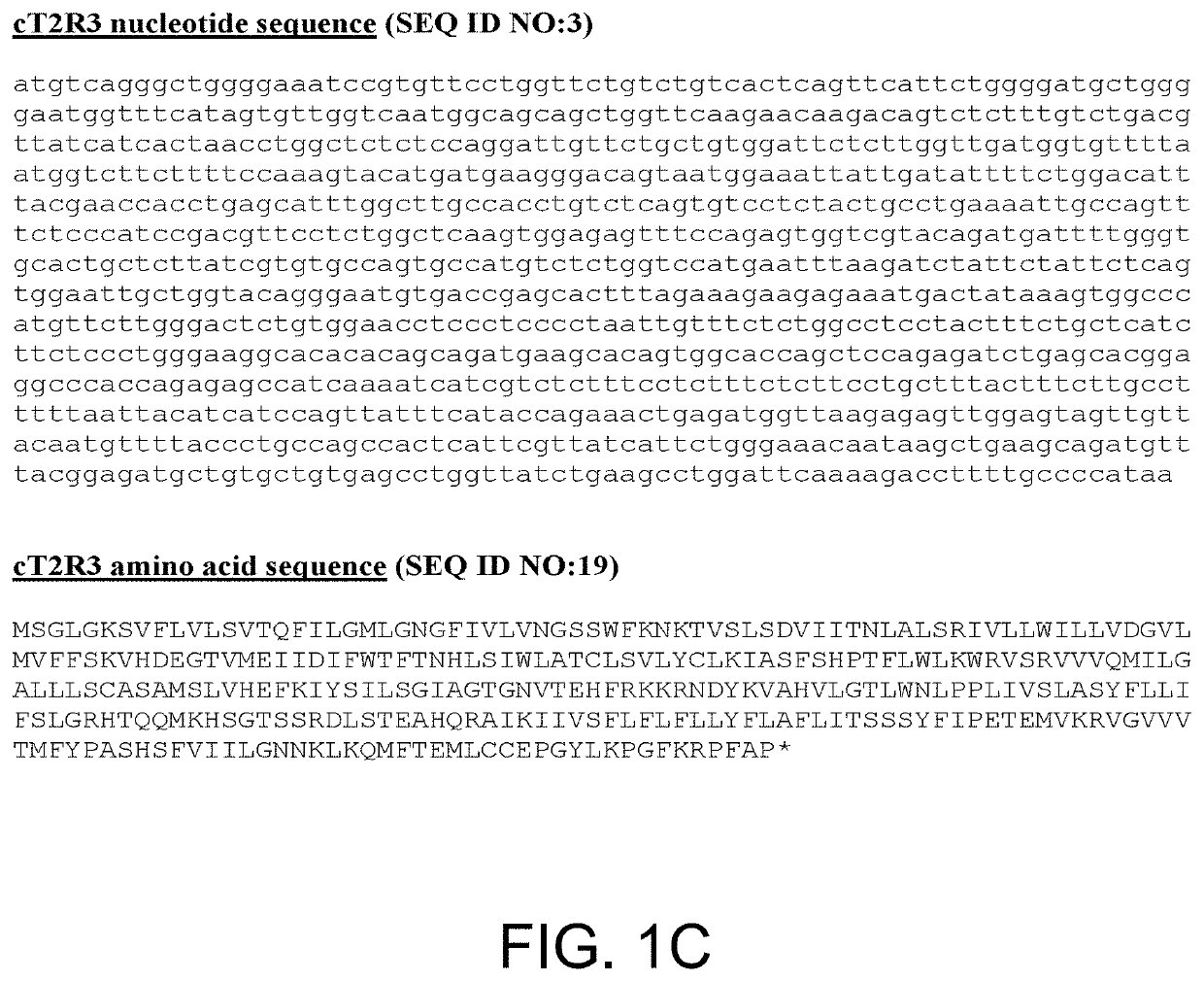Screening methods using canine t2r receptors and pet food products and compositions identified using the same
a technology of canine t2r receptor and t2r receptor, which is applied in the direction of animal/human proteins, peptides, instruments, etc., can solve the problems of notorious finicky domestic animals, and achieve the effects of enhancing, increasing, decreasing, and enhancing, increasing, decreasing and/or modulating the activity and/or expression of a bitter taste receptor
- Summary
- Abstract
- Description
- Claims
- Application Information
AI Technical Summary
Benefits of technology
Problems solved by technology
Method used
Image
Examples
example 1
Model of Interactions Between Canine T2R Receptors and Putative Binding Compounds
[0164]The present example describes the computational modeling of canine bitter taste receptors (T2Rs) to identify putative bitter taste receptor modulators.
[0165]Homology models of canine T2R receptors were based on crystal structure of 3 SN6 from Protein Data Bank (PDB). 3 SN6 is the crystal structure of β2 adrenergic receptor from Group A GPCR with bound agonist (BI-167107 from Boehringer Ingelheim). (Rasmussen et al., Nature, 477: 549-555 (2011)). The models were built using the I-TASSER Suite of programs (Yang et al., Nat Methods, 12: 7-8 (2015)) and Modeller (Eswar et al., Curr Protoc Bioinformatics, 15: 5.6.1-5.6.30 (2006)), which is part of the Discovery Studio (DS) suite of programs from Accelrys (Discovery Studio (DS) is suite of interactive modeling and simulation programs from the Accelrys corporation).
[0166]The bitter compounds were docked into the active site of canine bitter receptors. Th...
example 2
ation of Canine Bitter Receptor (T2R) Modulators Using In Vitro Assays
[0168]The present example describes an in vitro assay for identifying compounds that modulate the activation of the canine bitter taste receptor (T2R).
[0169]Compounds identified by in silico modeling with a bitter taste receptor, as detailed above in Example 1, as putative bitter taste receptor modulators will be selected for further testing in vitro. In vitro functional characterization of the selected modulators will be used to evaluate the effectiveness of a putative modulator compound in activating or inhibiting the bitter taste receptor.
[0170]HEK293 cells (or other suitable expression system) that stably or transiently express a canine bitter taste receptor (e.g., canine T2R1, T2R2, T2R3, T2R4, T2R5, T2R7, T2R10, T2R12, T2R38, T2R39, T2R40, T2R41, T2R42, T2R43, T2R62, or T2R67) will be exposed to putative compounds to modulate the activity and / or expression of the bitter taste receptor.
[0171]An exemplary meth...
example 3
ation of Canine Bitter Receptor (T2R) Modulators Using In Vitro Assays
[0174]The present example describes an in vitro assay for identifying compounds that modulate the activation of the canine bitter taste receptor (T2R) by a T2R ligand.
[0175]Compounds identified by in silico modeling with a bitter taste receptor, as detailed above in Example 1, as putative bitter taste receptor modulators will be selected for further testing in vitro. In vitro functional characterization of the selected modulators will be used to evaluate the effectiveness of a putative modulator compound in modulating the activation of the bitter taste receptor by a bitter taste receptor ligand.
[0176]HEK293 cells (or other suitable expression system) that stably or transiently express a canine bitter taste receptor (e.g., canine T2R1, T2R2, T2R3, T2R4, T2R5, T2R7, T2R10, T2R12, T2R38, T2R39, T2R40, T2R41, T2R42, T2R43, T2R62, or T2R67) will be exposed to putative modulator compounds and a bitter taste receptor lig...
PUM
 Login to View More
Login to View More Abstract
Description
Claims
Application Information
 Login to View More
Login to View More - R&D Engineer
- R&D Manager
- IP Professional
- Industry Leading Data Capabilities
- Powerful AI technology
- Patent DNA Extraction
Browse by: Latest US Patents, China's latest patents, Technical Efficacy Thesaurus, Application Domain, Technology Topic, Popular Technical Reports.
© 2024 PatSnap. All rights reserved.Legal|Privacy policy|Modern Slavery Act Transparency Statement|Sitemap|About US| Contact US: help@patsnap.com










